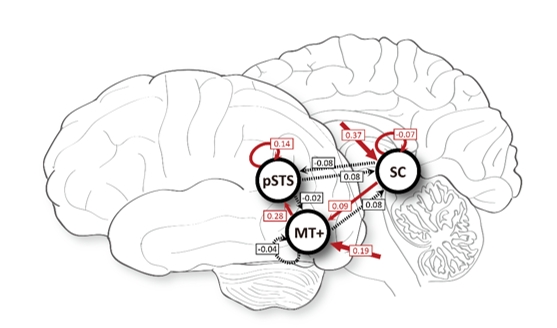Recent joint research led by Dr. JIANG Yi from Institute of Psychology, Chinese Academy of Sciences (CAS) and Institute of Biophysics, CAS has uncovered that the visual systems of both humans and animals can detect life motion from the environment at the earliest stage of visual processing. It also highlights the critical role of the superior colliculus (SC) in the perception of biological motion (BM) signals, suggesting a cross-species mechanism for processing BM early in the visual stream.
The study was published in Nature Communications on Nov. 7
The ability to detect the presence of living beings through their movements is fundamental to the visual system, playing a crucial role in survival behaviors such as hunting, predator avoidance, and social interaction. In experimental studies, the point-light display —commonly used to represent BM— shows the movement trajectories of humans or animals. Notably, most vertebrates, including humans, are highly adept at processing BM, indicating the existence of a cross-species mechanism for BM perception, potentially rooted in homologous brain architecture.
In light of this, the researchers conducted a cross-species study to explore the role of the SC in BM processing. The SC, lying on the roof of the mammalian midbrain (with a homologous structure known as the optic tectum in non-mammalian vertebrates), receives direct input from the retina and transmits this information to higher visual processing structures. Using high-field (3T) and ultra-high-field (7T) functional magnetic resonance imaging, the researchers recorded the neural responses of the SC to BM in both humans and macaque monkeys. Their findings revealed that the SC selectively responds to BM.
The SC is a structurally layered region, with its superficial layers receiving direct retinal input. To better understand how the SC processes BM signals at different depths, the team analyzed neural responses at various layers. They found that the selective response to BM was most pronounced in the superficial layers, decreased in the intermediate layers, and was minimal in the deeper layers.
Additionally, the researchers used dynamic causal modeling to investigate the connections between the SC and other brain regions involved in BM processing. The results revealed a functional pathway in the human brain, where BM information is transmitted from SC, through the middle temporal visual complex, to the posterior superior temporal sulcus.
This study, entitled" Detecting biological motion signals in human and monkey superior colliculus: a subcortical-cortical pathway for biological motion perception", is now available online.

Figure 1. Dynamic causal modeling analysis reveals the functional connectivity pathway involved in BM perception. Credit: Dr. LU Xiqian.
